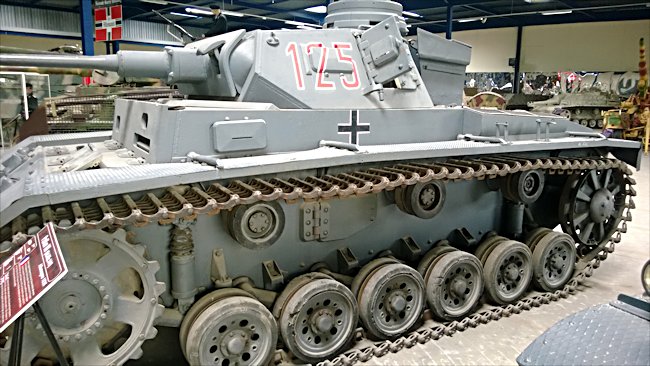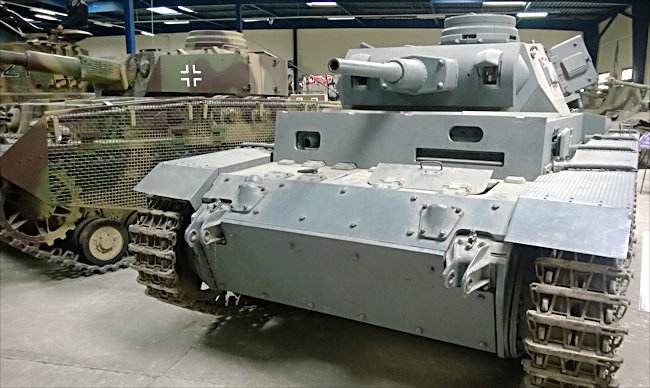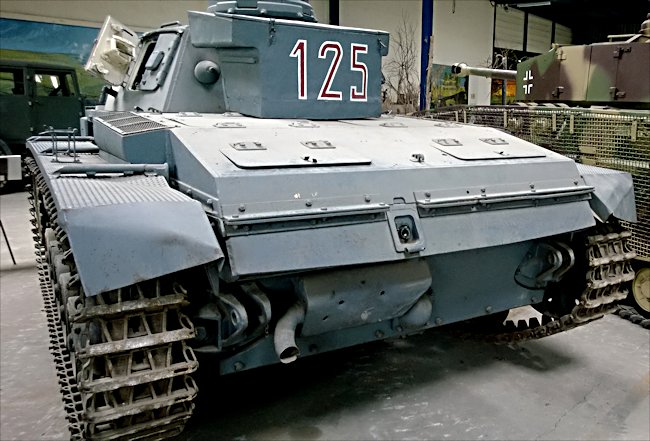The Panzer III Ausf. H Tank
This German Panzer III Ausf H tank panzerkampfwagen 3 Sd.Kfz.141 can be found at the French Tank Museum in Saumur in the Loire Valley. The Museum is called Musée des Blindés ou Association des Amis du Musée des Blindés, 1043, route de Fontevraud, 49400 Saumur, France www.museedesblindes.fr . The word Blindés means armoured.

German Panzer III Ausf H tank panzerkampfwagen Sd.Kfz.141. All Panzer III tanks had six small track wheels not eight like on the Panzer IV.
German Panzer III vs French Char B1-bis tank
The German panzer crews were in for a nasty shock when they invaded France in 1940. They suddenly became acutely aware of the failing of their Panzer I, Panzer II, Panzer III and the infantry support Panzer IV tanks. They were under protected and did not have enough fire power to effectively deal with enemy heavy tanks on a one to one bases.
The only way they could success fully deal with heavily armoured tanks like the British Matilda II or the French Char B1-bis was to attack them like a wolf pack and get in a position that they could shoot the rear and sides of the enemy tanks.
A good example of this was on the 17th May 1940 during the Battle of France near the town of Mortiers. The German tank crews of the six panzer III tanks from the 1st Panzer Regiment felt confident in the abilities of their machines. They came across a single French Char B1-bis tank. They were horrified when the shells from their 37mm guns just bounced of the front and side armour of this French monster.

Note the extra bolted on armour on the front of this Panzer III Ausf H tank panzerkampfwagen Sd.Kfz.141
The order came to rush the tank and get behind it. The Panzer III was much more mobile than the Char B1 who was heavy and slow. The managed to close within 300 metres behind it. One tank kept firing into the rear, others concentrated on the turret and some fired at the side. When the enemy tank tried to move to face them the German tank crews repositioned to get out of harm's way.
They peppered the tank with shot after shot. The French crew eventually bailed out. Their face, arms, legs chest and backs were bleeding from little cuts caused by sharp metal flakes that had been flying around inside the tank. These were caused by a thin layer of the armour plate violently peeling away when it bulged after being hit by a German shell.
The after action report recorded "Although completely saturated by hits none of the 20mm, 37mm, 75mm and special rounds were effective in penetrating the armour. The tank was only brought to a halt when a 37mm round pierced the engine grill on the left side of the tank, pierced the engine and disabled it."

Rear view of the Panzer III Ausf H tank panzerkampfwagen Sd.Kfz.141
In 1940 the German Panzer Mark III tank was intended to be the Army's main battle tank and was expected to make up 75% of its tank strength. It was powered by a 300 HP Maybach petrol engine. It weighed 20 tonnes and had a road speed of 20 mph. It was designed to fulfil and anti-tank role and was fitted with the same 37mm anti-tank gun used by the infantry.
To the tank crews horror, as already mentioned, they found that its shells bounced off the armour thickness of the French char B1 heavy tank and the British Matilda heavy tank. It only had a maximum armour thickness of 30mm which offered little protection from a Char B1's 75mm gun.
Due to production problems only 350 Panzer Mark III tanks were available to the German army at the start of the blitzkrieg attack during the battle of France in May 1940. The Panzer three had six small road wheels on each side, independently sprung on a torsion bar. Very little of it suspension system was exposed to enemy fire. However difficulties with rough terrain led to this type of system to be abandoned in later models.
In 1938. It was decided to upgrade the tanks gun to 50 mm but this new model was not available when the offensive began. During the course of the offensive 40 of these upgraded Panzer III tanks were completed and rushed to the front.
Where can I find other preserved Panzer III Tanks?
- Pz Kpfw III Ausf. F - Musée des Blindés, Saumur, France
- Pz Kpfw III Ausf. F - National Armor and Cavalry Museum Fort Benning, GA, USA
- Pz Kpfw III Ausf. F - Wreck - National Armor and Cavalry Museum Fort Benning, GA, USA
- Pz Kpfw III Ausf. F - Great Patriotic War museum, Minsk, Belarus
- Pz Kpfw III Ausf. F - Bunichevo park, Mogilev, Mahilyow Voblast, Belarus
- Pz Kpfw III Ausf. H - Academy of the armed forces of the Ukraine, Kiev, Ukraine
- Pz Kpfw III Ausf. J - Wreck - Kolbpak forest, Putivl, Sumy Oblast, Ukraine
- Pz Kpfw III Ausf. J - Kubinka Tank Museum, Russia
- Pz Kpfw III Ausf. J/B - Central Museum of the Great Patriotic War 1941 - 1945, Park Pobedy, Moscow, Russia
- Pz Kpfw III Ausf. L - Bovington Tank Museum England
- Pz Kpfw III Ausf. L - Wreck - Central Museum of the Great Patriotic War 1941 - 1945, Park Pobedy, Moscow, Russia
- Pz Kpfw III Ausf. L - National Armor and Cavalry Museum, Fort Benning, GA, USA
- Pz Kpfw III Ausf. M - Wheatcroft Collection England
- Pz Kpfw III Ausf. M - Forsvarsmuseet Oslo storage, Trandum, Norway
- Pz Kpfw III Ausf. M - Deutsches Panzermuseum Munster, Germany
- Pz Kpfw III Ausf. M - Etimesgut Tank Müzesi, Ankara, Turkey
- Flammpanzer III Ausf. M - Wehrtechnische Dienststelle Trier, Germany
- Pz Kpfw III Ausf. N - Wreck - Troms Forsvarsmuseum, Setermoen, Norway
- Pz Kpfw III Ausf. N - Panserparken, Rena Military Camp, near Elverum, Norway
- Pz Kpfw III Ausf. N - Private collection, Denmark
- Pz Kpfw III Ausf. N - Bovington Tank Museum England
- Pz Kpfw III Ausf. N - Auto and Technik Museum Sinsheim Germany
- Pz Kpfw III Ausf. N - Private collection, Finland
- Pz Kpfw III Ausf. N - Armoured Weapons Museum, Land Forces Training Centre Poznan, Poland
- Pz Kpfw III Ausf. N - Aberdeen U.S. Army Ordnance Museum, MD, USA
- Pz Kpfw III Ausf. N - National Armor and Cavalry Museum, Fort Benning, GA, USA
- Source - Pierre-Oliver Buan - http://the.shadock.free.fr/Surviving_Panzers.html
WW2 Tank books

